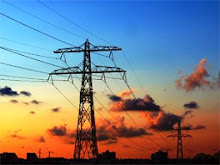Switch on the light. Is the filament glowing because of a heavy gust of wind, or is it nuclear fission?
If you flick a switch today, the light goes on because of coal. Almost half the power generated in Britain on Tuesday came from coal and a bit more than a third from natural gas. Nuclear power stations were contributing 17 per cent and windmills provided 0.6 per cent.
It's a day's work in the power industry and it is 16 years since the Kyoto conference on climate change, when this country signed up to a process that would seek to avert global warming by weaning the world off the combustion of oil, gas and coal. Since then we have had two Energy White Papers, one Energy Review, the launch of European carbon trading, the decline of North Sea gas, the promotion of wind farms and the eleventh-hour rescue of Britain's nuclear industry. After all the politics, we are breathless as our bright new whirligigs stand motionless on a beach horizon.
The wind has failed, as it does during periods of intense heat and cold, and although we have built, with enormous subsidy, enough wind turbines to generate 5 per cent of our electricity, no more than 1 per cent is operational when we need it. Like Coleridge's ancient mariner, the nation is becalmed, a painted ship on a painted ocean and we have gone back a century, hewing the same coal that first put Britain on the fast track to the Industrial Revolution.
The reason why we are still stuffing black lumps of carbon into furnaces is simple: it makes economic sense and the financial markets are shouting this message louder than ever before.
Everyone loves to hate financial markets — casinos operated by spivs, jungles filled with rapacious speculators — but they provide warnings when things are about to go wrong and the carbon market is no exception. The price of European Union allowances to emit carbon dioxide has collapsed and it has reached a level where even the greenest of utilities might be tempted to flirt with a hod of dirty brown coal.
Mills and factories throughout Europe are dumping their allowances on the market and grabbing the cash. You will remember that the allowances (EUAs) were issued free to power companies and other carbon emitters, but the volume was capped to ensure scarcity and that was expected to drive up the price, forcing polluters to reduce emissions or pay for expensive permits.
Recession has changed the equation and energy consumption is falling. Factories are running at half-capacity, the suppliers are demanding cash up front, the banks are not lending and somebody in the Treasury found a bundle of certificates, EUAs. In July, a tonne of carbon sold for €35, but today it fetches less than €9. Too bad, thinks the finance director, dump them anyway. If the politicians are still quacking about the climate in two years' time, we will buy them back, if we still have a business.
If you believe that to be cynical or just pragmatic, consider the behaviour of the Government of Japan, which is doing a carbon trade with Ukraine. Under the Kyoto Protocol, governments are able to sell surplus rights to emit carbon to other nations. Like emissions trading between companies, it means that governments that succeed in reducing carbon emissions can sell “surplus” carbon to struggling nations.
No one thought that the whole process might go backwards. The benchmark against which Kyoto's carbon world was pegged was 1990 and since then the former Soviet satellite has struggled to stay upright. Desperate for cash and with its economy in freefall, Ukraine, too, has found some certificates in the bottom drawer. Japan is offering to buy Ukraine's “surplus” carbon for €300 million. Should we begrudge Ukraine the opportunity to pledge the planet's future to a Japanese pawnbroker? If Ukrainians are lucky, the money earned will not be squandered and might help to pay the bill for imported Russian gas over the rest of the winter.
We should not be too critical, because Europe is about to face a big decision over coal. The fuel is abundant and at present very cheap, the main reason why power stations love it. The margin earned from burning coal, according to Société Générale, is about €15 per megawatt hour, compared with €7 from natural gas — and those figures include the cost of the EUAs.
At Deutsche Bank, Mark Lewis, the head of carbon research, fears that the price may have fallen to a level at which some utilities may be tempted to invest in conventional coal-fired power stations. The carbon trading system was developed to stimulate investment in clean technologies, such as carbon capture and storage (CCS). “A price at this level won't deliver what the carbon market was intended to deliver,” he says. Carbon needs to be four times as expensive to make CCS plausible.
Meanwhile, the UK must make a huge decision. We have promised to shut down seven old coal plants by 2015 because they emit too much sulphur. These can supply 12 gigawatts, or a sixth of UK capacity. Ideally, we would fill the gap with nuclear power, but EDF has made it clear that the first new British nuke won't be ready until 2017, supplying less than 2 gigawatts.
It is self-evident that we must carry on burning coal for the time being and politicians must stop telling lies about energy. They must begin to set plausible targets, explain their true cost and how they will be achieved. The impact of recession on industrial demand is one reason why the carbon price is weak. The other reason is credibility.
Source: The Times



No comments:
Post a Comment